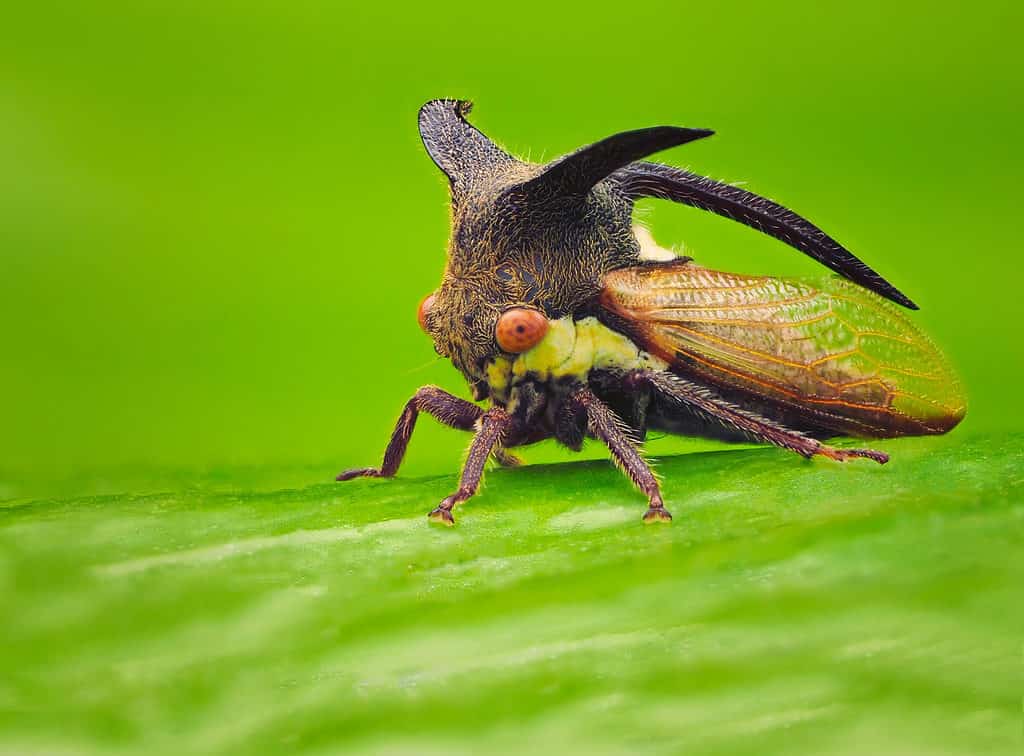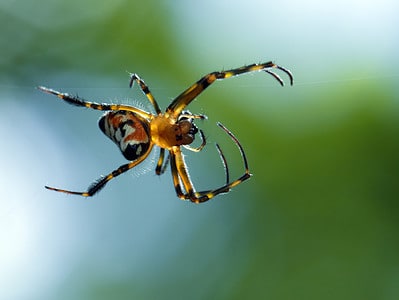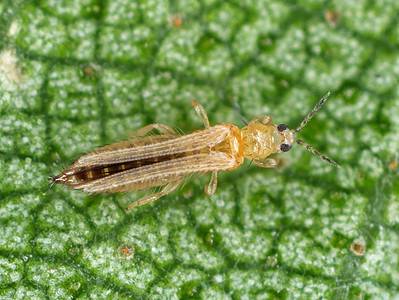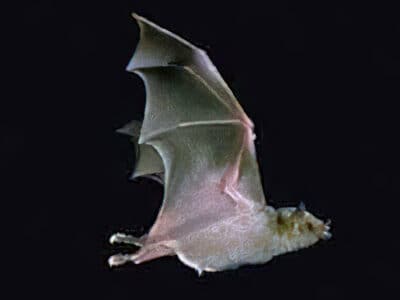Treehopper
Ceresa taurina
The colors, shapes, and intricacies of treehoppers’ helmets makes them unique and visually stunning.
Advertisement
Treehopper Scientific Classification
- Kingdom
- Animalia
- Phylum
- Arthropoda
- Class
- Insecta
- Order
- Hemiptera
- Family
- Membracidae
- Genus
- Stictocephala
- Scientific Name
- Ceresa taurina
Read our Complete Guide to Classification of Animals.
Treehopper Conservation Status
Treehopper Facts
- Name Of Young
- nymphs
- Fun Fact
- The colors, shapes, and intricacies of treehoppers’ helmets makes them unique and visually stunning.
- Biggest Threat
- birds
- Most Distinctive Feature
- helmets
- Distinctive Feature
- brilliant colors
- Other Name(s)
- insect brownies
- Age Of Independence
- 75 days to go from egg to adult
- Habitat
- trees and shrubs
- Predators
- birds
- Diet
- Herbivore
- Favorite Food
- tree and plant sap
- Common Name
- treehopper
- Special Features
- protruding pronotum
- Number Of Species
- 3502
- Location
- all continents except Antarctica
Treehopper Physical Characteristics
- Lifespan
- 60 days
- Length
- 0.08 to 0.8 inches
- Aggression
- Low
View all of the Treehopper images!
Treehopper is the umbrella term for over 3,500 insects that are part of the Membracidae family of distinct-looking bugs. These unusual creatures have long-fascinated scientists due to a dazzling array of fascinating, protruding backs and varying colorful appearances. The bugs exist almost everywhere on earth and collectively feed on more than 100 families of plants.
Read on to learn more about this fascinating collection of bizarre-looking bugs.
5 Treehopper Facts
- Treehoppers are sometimes called “insect brownies” due to their thin, elf- or fairy-like appearances.
- Treehoppers range in brilliant colors from bronze to greens, and many feature distinctive markings such as stripes or spots.
- Treehoppers are related to cicadas and leafhopper insects.
- You can find treehoppers everywhere in the world except Antarctica; however, they prefer the tropics, and there are only five species in Europe.
- May and June are the most active months for treehoppers when the larvae have hatched from their eggs and are starting to look for mates and food of their own.
Treehopper Species, Types, and Scientific Name
This family of insects carries the name Membracidae, which comes from the Greek word ‘membrax,’ which refers to a type of cicada. They are part of the superfamily Cicadoidea, related to cicadas and leafhoppers. The colloquial “treehopper” comes from these bugs primarily residing in trees, though they can often be found in shrubs or grasses.
Appearance: How To Identify Treehoppers

Treehoppers vary in shape, size, and color, as seen with this horned treehopper.
©fendercapture/Shutterstock.com
Treehoppers vary in shape, size, and coloring, but the family shares many distinct appearances that have long fascinated researchers. These bugs carry a protruding pronotum, the shell that covers and protects the insect’s thorax. The pronotum extends up and over the body, making the insects seem much taller than they actually are. Depending on the species, treehopper pronotums expand into unusual shapes and colors designed for camouflage or mimicry, such as leaves or plant thorns.
A treehopper also has strong rear leg muscles that help it “hop” from spot to spot. On the front side, these insects have sucking mouth appendages — similar to a mosquito — that allow them to pierce a tree’s bark and consume the sap within. Their mouths have two sharp tubes: one to inject saliva to prevent the tree’s immune system from closing the sap hole and the other with which to eat.
Unlike adults, larvae have a long waste tube responsible for discharging excess sap as honeydew far away from their bodies to prevent infection. It’s impossible to determine male from female treehoppers except by examining genitalia.
Treehoppers range in size from 0.08 to 0.8 inches, depending on the species. Individual treehoppers usually live for only a few months.
Habitat: Where to Find Treehoppers
Most of these insects occur in the tropics but exist on all continents except Antarctica. They are a diverse, reasonably common group of bugs, and you can find different species on various plants. While many variations separate individual species, identifying the bug as a treehopper by its protruded pronotum is key.
Treehopper species adapt their camouflage and coloring to their behavior and habitat. Typically, bugs will stay motionless when they sense danger, standing where one would expect to see thorns or twigs. Several treehoppers clustered together can make for some convincing disguises.
Evolution and History
One of the most fascinating and puzzling evolutionary aspects of the treehopper is the origination of their dramatically diverse helmets, which are extremely unlike other insects in nature.
A team of researchers in 2011 postulated the hypothesis that the unusual shapes were once a highly modified set of wings, rather than a pronotum – a normal part of the thorax. If this is true, it means that treehoppers are the first insects in 250 million years to grow a third set of wings on their thorax. While it was contested then, more recent genetic research suggests that the helmet structures are indeed part of the thorax but rely on wing genetic material to develop.
These genetics are closely related to the bug’s cousin, the leafhopper, which does not develop helmets out of the pronotum. They also allow the colors, shapes, and intricacies of the treehoppers’ helmets to be unique and visually stunning.
Diet: What Do Treehoppers Eat?
Treehoppers bite into plant or tree stems to feed upon the sweet sap within. Their mouthparts spit saliva into the plant’s hole to keep it open and can sometimes stick with a single plant’s sap for the rest of their short lives.
Different treehopper species feed on different types of plants, such as trees and woody plants, shrubs, and bushes. However, their larvae are a different story. Female treehoppers deposit their eggs into curved slits carved into the bark. The young bugs hatch in the spring as pale-green “nymphs,” which feed on the sap of nearby non-woody plants such as grasses and weeds.
Sometimes when these bugs consume sap. They produce concentrated honeydew, which attracts ants. Some species of treehopper have developed a mutualism with ants, which protect them from predators in exchange for a share of the treehoppers’ sappy residue. Treehoppers also use their camouflage to protect themselves and ants from predators, including many species of birds and other insect-eating creatures.
Related Animals:
View all 133 animals that start with TTreehopper FAQs (Frequently Asked Questions)
Are treehoppers harmful?
While treehoppers feed on plants, they are rarely an issue for human agriculture or humans. Overall, only a few species of these bugs are considered pests. Their feeding is harmless, but sometimes the egg-laying process can cause damage to thinner twigs or stems.
Do treehoppers bite?
Treehoppers would rather not be disturbed than disturb others. They don’t sting or bite people, instead opting to hide on plants by imitating thorns or twigs.
How do you get rid of treehoppers?
While very few species of treehoppers are considered pests, you may want to remove them from your plants. You can make an insecticide with dish soap and warm water; spray it generously on plants to kill hoppers on contact.
Thank you for reading! Have some feedback for us? Contact the AZ Animals editorial team.
Sources
- Nature, Available here: https://www.nature.com/articles/nature09977
- Nature, Available here: https://www.nature.com/articles/s41559-019-1054-4

















